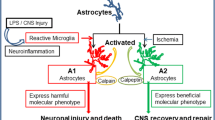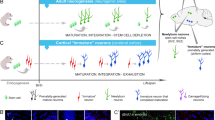We assessed changes of olfactory bulbs in rata with 6-hydroxydopamine destruction of the substantia nigra. The expression of marker proteins of immature and differentiated neurons and glia (vimentin, PSA-NCAM, tyrosine hydroxylase, and S100) was analyzed by immunohistochemical and morphometric methods. The number of periglomerular dopamine neurons and astroglia in the olfactory bulbs increased on the side of toxin injection and expression of PSA-NCAM and vimentin increased in the rostral migratory stream. Destruction of the substantia nigra shifted differentiation of neuronal progenitors towards the dopaminergic phenotype and increased their survival in the olfactory bulbs, which can be explained by increased expression of PSA-NCAM.
Similar content being viewed by others
References
Alexeeva NS, Illarioshkin SN, Ponomareva TA, Fedotova EYu, Ivanova-Smolenskaya IA. The olfactory disturbances in Parkinson’s disease. Nevrol. Zh. 2012;17(1):10-14. Russian.
Kim AR, Ugriumov MV. Cooperative synthesis of dopamine in the striatum of normal and parkinsonial mice. Doklady Biochem. Biophysics. 2015;460(1):49-52.
Aponso PM, Faull RL, Connor B. Increased progenitor cell proliferation and astrogenesis in the partial progressive 6-hydroxydopamine model of Parkinson’s disease. Neuroscience. 2008;151(4):1142-1153.
Cave JW, Fujiwara N, Weibman AR, Baker H. Cytoarchitectural changes in the olfactory bulb of Parkinson’s disease patients. NPJ Parkinsons Dis. 2016;2. ID 16011. doi:https://doi.org/10.1038/npjparkd.2016.11
Chiu WH, Carlsson T, Depboylu C, Höglinger GU, Oertel WH, Ries V. Selegiline normalizes, while l-DOPA sustains the increased number of dopamine neurons in the olfactory bulb in a 6-OHDA mouse model of Parkinson’s disease. Neuropharmacology. 2014;79:212-221.
Fricke IB, Viel T, Worlitzer MM, Collmann FM, Vrachimis A, Faust A, Wachsmuth L, Faber C, Dollé F, Kuhlmann MT, Schäfers K, Hermann S, Schwamborn JC, Jacobs AH. 6-hydroxydopamine-induced Parkinson’s disease-like degeneration generates acute microgliosis and astrogliosis in the nigrostriatal system but no bioluminescence imaging-detectable alteration in adult neurogenesis. Eur. J. Neurosci. 2016;43(10):1352-1365.
Gascon E, Vutskits L, Jenny B, Durbec P, Kiss JZ. PSA-NCAM in postnatally generated immature neurons of the olfactory bulb: a crucial role in regulating p75 expression and cell survival. Development. 2007;134(6):1181-1190.
He XJ, Nakayama H. Transiently impaired neurogenesis in MPTP mouse model of Parkinson’s disease. Neurotoxicology. 2015;50:46-55.
Höglinger GU, Alvarez-Fischer D, Arias-Carrión O, Djufri M, Windolph A, Keber U, Borta A, Ries V, Schwarting RK, Scheller D, Oertel WH. A new dopaminergic nigro-olfactory projection. Acta Neuropathol. 2015;130(3):333-348.
Lazarini F, Gabellec MM, Moigneu C, de Chaumont F, Olivo-Marin JC, Lledo PM. Adult neurogenesis restores dopaminergic neuronal loss in the olfactory bulb. J. Neurosci. 2014;34(43):14,430-14,442.
Liu BF, Gao EJ, Zeng XZ, Ji M, Cai Q, Lu Q, Yang H, Xu QY. Proliferation of neural precursors in the subventricular zone after chemical lesions of the nigrostriatal pathway in rat brain. Brain Res. 2006;1106(1):30-39.
Pifl C, Reither H, Del Rey NL, Cavada C, Obeso JA, Blesa J. Early paradoxical increase of dopamine: a neurochemical study of olfactory bulb in asymptomatic and symptomatic MPTP treated monkeys. Front. Neuroanat. 2017;11:46. doi:https://doi.org/10.3389/fnana.2017.00046.
Stanic D, Finkelstein DI, Bourke DW, Drago J, Horne MK. Timecourse of striatal re-innervation following lesions of dopaminergic SNpc neurons of the rat. Eur. J. Neurosci. 2003;18(5):1175-1188.
Sui Y, Horne MK, Stanić D. Reduced proliferation in the adult mouse subventricular zone increases survival of olfactory bulb interneurons. PLoS One. 2012;7(2):e31549. doi: https://doi.org/10.1371/journal.pone.0031549.
Winner B, Geyer M, Couillard-Despres S, Aigner R, Bogdahn U, Aigner L, Kuhn G, Winkler J. Striatal deafferentation increases dopaminergic neurogenesis in the adult olfactory bulb. Exp. Neurol. 2006;197(1):113-121.
Author information
Authors and Affiliations
Corresponding author
Additional information
Translated from Byulleten’ Eksperimental’noi Biologii i Meditsiny, Vol. 166, No. 12, pp. 783-787, December, 2018
Rights and permissions
About this article
Cite this article
Voronkov, D.N., Khudoerkov, R.M., Sal’nikova, O.V. et al. Immunohistochemical Assessment of the Compensatory Responses in Rat Olfactory Bulbs after 6-Hydroxydopamine-Induced Lesion of the Substantia Nigra. Bull Exp Biol Med 166, 811–815 (2019). https://doi.org/10.1007/s10517-019-04446-8
Received:
Published:
Issue Date:
DOI: https://doi.org/10.1007/s10517-019-04446-8




